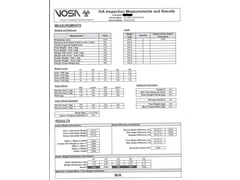

IVA Fail sheet 3
Hope that helps give some indications of what might be expected.
Adrian

Just been reading thru the IVA section of CKC's 2010 guide.
It says there is now an IVA requirement for a secondary braking test to 'provide a braking force of at least 30% of Design Gross Vehicle
Weight'. The secondary test assumes one half of a split system has failed.
This shouldn't cause a problem in a diagonally split system but could cause a problem in a lightweight car with a front/back split where the rear
brakes are often backed off quite considerably. Setting them correctly may also increase the potential for the rear wheels to lock under braking.
My system has a twin master cylinder and is plumbed front/back. Is it worth switching to a diagonal system ?
In case you do not have a copy of the manual you will find it here down the page.
Link
Reading section 9A you have this comment
Note 1: The secondary system can be either one half of the split system (following failure of the other half) or secondary can be on the handbrake
(Secondary/Park).
The handbrake effort is generally not effected by the hydraulic system, unless hydraulic of course.
I also think that on an axle split system as per the original Sierra design, if the front brake line failed more force on the pedal would still have
the rears locking it does not take much to lock them.
I guess black art, but of the handbrake can lock the backs then I think you would be OK.
I am sure someone will correct me if wrong.
Adrian
quote:
Originally posted by AdrianH
I also think that on an axle split system as per the original Sierra design, if the front brake line failed more force on the pedal would still have the rears locking it does not take much to lock them.
I did on mine with the handbrake as that was not one of my fail points. 37% from the look of it.


IVA Fail sheet 3
Hope that helps give some indications of what might be expected.
Adrian
There's also this bit under brake performance.
2. The service brake performance must be at least 60%, (of the CLW or DGW as determined to be the highest) or more than half the road wheels lock.
3. The secondary brake performance must be at least 30%, (of the CLW or DWG as determined to be the highest) for each half of the split system.
I assume the sum
'at least 60% of DWG' = 'at least 30' + 'at least 30'
is done from the roller brake tests. I would expect the car would do much better than 60% say 90% (see above posters test results, approx 54%/46% F/R
of 99.5%) so the rear wheels in a split system could be half as efficient as the fronts and still score a pass.
I would stick with the front/rear split and expect a pass. Changing to a diagonal split does away with much of the benefits of dual brake
cylinders.
[Edited on 19/11/09 by Dusty]
quote:
Originally posted by Dusty
I assume the sum
'at least 60% of DWG' = 'at least 30' + 'at least 30'
is done from the roller brake tests. I would expect the car would do much better than 60% say 90% (see above posters test results, approx 54%/46% F/R of 99.5%) so the rear wheels in a split system could be half as efficient as the fronts and still score a pass.